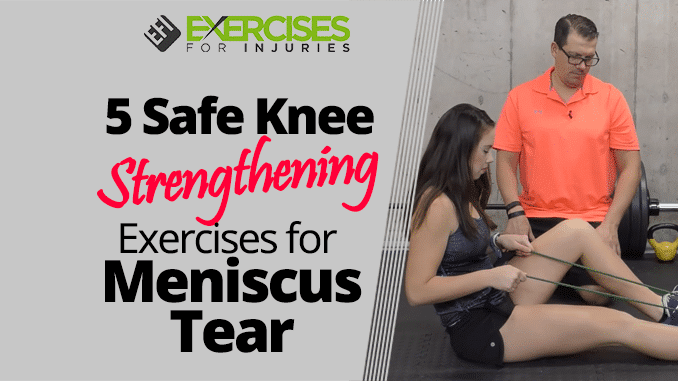I wanted to show you a few safe knee-strengthening exercises for meniscus tears.
I had Jenna to demonstrate the
1. Flexion Extension
Begin the knee strengthening exercises for meniscus tears in an upright standing position and put your one hand up against the wall. Place your weight onto one leg, and then swing the other leg forward and backward. Repeat the movement.
Start with one set of 5 reps in each direction. Perform this exercise in a smooth, controlled movement with a good contraction at the end of each of movement. The intensity is light. This exercise targets the hips and the isolation contraction of the muscles around the knee.
The purpose of this exercise is twofold. The first is when you stand onto one leg, you isometrically work on the muscles around the knee and in the hip. The second is when you swing the leg of the injured knee, and you work on the muscles around the hip.
When you have a knee injury, it is very important to make sure that you have a good strong hip to help you recover from the meniscus tear and subside pain and prevent a future injury.
2. Heel Slides With Band
Begin in a nice, upright sitting position. Bend your knees, step both legs into the tubing below the arches of your feet and grab the handles. Straighten your legs out front, then bring them back to the start position and repeat the movement.
If doing this exercise with both legs is too challenging for you, you can do it with one leg at a time.
Heel Slides With Band on Both Legs
Start with one set of 5 reps. Then you can progress to 10 repetitions. Perform this exercise in a smooth, controlled movement with a good contraction at the end position, specifically the muscles around the knees. The intensity is light. This exercise mainly works on the activation, endurance and strength of the muscles around the knees.
The purpose of this exercise is twofold. The first is to work on the range of motion of the knee for flexion extension. The second is to work on the activation, endurance and strength of the muscles around the knees and to utilize the resistive tubing to increase the challenge of the exercise.
3. Hip Abduction
Begin the in an upright standing position. Put one hand against the wall to help with balance so you can focus on the isolation of the exercise and work on the muscles that you need to exercise. Place your weight onto one leg, and lift the other leg out to the side at about a 30- to 45-degree angle. You are looking for a minimum movement in the hip and not to get some excessive movement. Bring your leg back down and repeat the movement.
Hip Abduction
Start with one set of 5 reps on each side. Perform this exercise in a smooth, controlled movement with a good contraction at the end position. The intensity is light.
The purpose of this exercise is twofold. First is to strengthen out the outer part of the hip. When you bring the leg out to the side, if that’s the injured knee, then it strengthens out the outer part of the hip. A strong hip is important to prevent knee pain and recover knee injury.
The second benefit or purpose of this exercise is if the injured leg is the one you used to stand on, it isometrically contract the muscles around the knees and hips. The injured leg will work the whole time and target the important muscles, which are helpful for the meniscus tear recovery.
4. Static Quad Contraction
Begin in a nice and upright sitting position and put your hands to the side. Contract your quads, tighten the quad muscle, hold it for a second, then relax and repeat the movement.
Contraction of the quad will straighten out the leg more and press the end range extension.
Static Quad Contraction
Start with one set of 5 reps. Perform this exercise in a nice, smooth contraction at the end of the movement for a hold of a second. The intensity is light. This exercise works on the activation, endurance and strength of the quadriceps.
The purpose of this exercise is to train the activation, endurance, and strength of the quadriceps muscles, which might not be working properly after the meniscus tear.
5. Glute Bridge
Lie on your back on the floor and put your arms to the side. Relax the upper body. Bend your knees and feet are hip-width apart. Push through the heels and bring your hips up. Maintain a good alignment with the knees, hips and shoulders. Bring the hips back down and repeat the movement.
Glute Bridge
Start with one set of 5 reps then you can progress to 10 repetitions. Perform this exercise in a smooth, controlled movement with a good contraction of the glutes and hamstrings. The intensity is light.
The purpose of this exercise is to work on the muscles around the hips, specifically the glutes and hamstrings to help with the recovery and prevention of a future injury.
Give these safe knee strengthening exercises for meniscus tears a go.
If you want to overcome your meniscus tear in a fast, simple and safe way, then check out the Meniscus Tear Solution program, here!
Take care!
Rick Kaselj, MS

